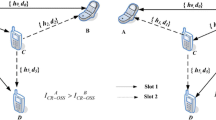Abstract
Peer-to-peer relay technique provides the opportunity of cooperative communication between users to achieve the transmission diversity. In this paper, the problem of relay selection and subcarrier allocation in peer-to-peer cooperative OFDMA system with channel distribution uncertainty is studied. The quality of service (QoS) requirements are characterized with the probabilistic constraints. The Kullback-Leibler (KL) divergence is adopted to describe the uncertainty of the channel state information (CSI), which follows a distribution deviated within a certain distance from the reference distribution. Since the probabilistic constraint is intractable, we resort to a tractable upper bound instead. The problem is solved by the interior point cutting plane (IPCP) method, which proceeds in round whereby an iterative method is designed to combine both golden section method and interior point method to find the saddle point of the constraint. Simulation results show the effectiveness of our algorithm.







Similar content being viewed by others
References
H.Y. Hsieh, R. Sivakumar (2004) On using peer-to-peer communication in cellular wireless data networks. IEEE Trans. Mob. Comput. 3(1):57
N. Shah, D. Qian, R. Wang (2012) MANET adaptive structured P2P overlay. Peer-to-Peer Networking and Applications 5(2):143
M. Zulhasnine, M. Huang, A. Srinivasan (2012) Towards an effective integration of cellular users to the structured Peer-to-Peer network. Peer-to-Peer Netw. Appl. 5(2):178
L. Lei, Z. Zhong, C. Lin, X. Shen (2012) Operator controlled device-to-device communications in LTE-advanced networks. IEEE Wirel. Commun. 19(3):96
V. Sreng, H. Yanikomeroglu, D.D. Falconer (2003) Relayer selection strategies in cellular networks with peer-to-peer relaying in. IEEE Vehicular Technology Conference 3:1949–1953
D. Ponukumati, F. Gao, C. Xing (2013) Robust peer-to-peer relay beamforming: A probabilistic approach. IEEE Commun. Lett. 17(2):305
D. Zheng, J. Liu, K.K. Wong, H. Chen, L. Chen (2012) Robust peer-to-peer collaborative-relay beamforming with ellipsoidal CSI uncertainties. IEEE Commun. Lett. 16(4):442
W. Shim, Y. Han, S. Kim (2010) Fairness-aware resource allocation in a cooperative OFDMA uplink system. IEEE Trans. Veh. Technol. 59(2):932
M. Alam, J. Mark, X. Shen (2013) Relay selection and resource allocation for multi-user cooperative OFDMA networks. IEEE Trans. Wirel. Commun. 12(5):2193
D. Zhang, Y. Wang, J. Lu (2010) QoS aware relay selection and subcarrier allocation in cooperative OFDMA systems. IEEE Commun. Lett. 14(4):294
G.A.S. Sidhu, F. Gao, W. Chen, A. Nallanathan (2011) A joint resource allocation scheme for multiuser two-way relay networks. IEEE Trans. Commun. 59(11):2970
D. Zhang, X. Tao, J. Lu, M. Wang (2011) Dynamic resource allocation for real-time services in cooperative OFDMA systems. IEEE Commun. Lett. 15(5):497
D. Michalopoulos, N. Chatzidiamantis, R. Schober, G. Karagiannidis (2011) Relay selection with outdated channel estimates in Nakagami-m fading. in IEEE International Conference on Communications
A. Ben-Tal, L. El Ghaoui (2009) A. Nemirovski. Robust optimization (Princeton University Press
S. Uryasev (2000) Probabilistic constrained optimization: methodology and applications, vol. 49 (Springer
T.Q. Quek, M.Z. Win, M. Chiani (2010) Robust power allocation algorithms for wireless relay networks. IEEE Trans. Commun. 58(7):1931
S. Mallick, M. Rashid, V. Bhargava (2012) Joint relay selection and power allocation for decode-and-forward cellular relay network with channel uncertainty. IEEE Trans. Wirel. Commun. 11(10):3496
W.L. Li, Y.J. Zhang, A.C. So, M.Z. Win (2010) Slow adaptive OFDMA systems through chance constrained programming. IEEE Transactions on Signal Processing 58(7):3858
N. Soltani, S. Kim, G. Giannakis (2013) Chance-Constrained Optimization of OFDMA Cognitive Radio Uplinks. IEEE Trans. Wirel. Commun. 12(3):1098
I. Ioannou, C. Charalambous, S. Loyka (2012) Outage Probability Under Channel Distribution Uncertainty. IEEE Trans. Inf. Theory 58(11):6825
Shimin Gong, Ping Wang, Yongkang Liu, Weihua Zhuang (2013) Robust power control with distribution uncertainty in cognitive radio networks. IEEE Journal on Selected Areas in Communications 31(11):2397
R.M Gray (2011) Entropy and information theory (Springer
W. Rhee, J.M. Cioffi (2000) Increase in capacity of multiuser OFDM system using dynamic subchannel allocation in. IEEE Vehicular Technology Conference:1085–1089
J.E. Mitchell (2003) Polynomial interior point cutting plane methods. Optimization Methods and Software 18(5):507
S.P. Boyd, L. Vandenberghe (2004) Convex optimization (Cambridge university press
J.L. Goffin, Z.Q. Luo, Y. Ye (1996) Complexity analysis of an interior cutting plane method for convex feasibility problems. SIAM J. Optim. 6(3):638
M. do Rosário Grossinho, S.A. Tersian (2001) An introduction to minimax theorems and their applications to differential equations, vol, 52 (Springer
D.S. Atkinson, P.M. Vaidya (1995) A cutting plane algorithm for convex programming that uses analytic centers. Math. Program. 69:1
Acknowledgments
The work was partially supported by National Basic Research Program of China under the grant no. 2010CB731803, by NSF of China under 61174127, 61001096, 61273181 and 60934003.
Author information
Authors and Affiliations
Corresponding author
Appendix
Appendix
1.1 Proof of Theorem 1
The case of k = 0 is obvious, we focus on the case of k > 0. The distribution functions of \(\gamma _{s, m0}^{n}\) and \(\gamma _{s, mk}^{n}\) are given as
According to the theorem of total probability, the distribution function of \(\sigma _{s, mk}^{n}\gamma _{r, mk}^{n}\) could be derived as follows:
where Dirac(⋅) denotes the dirac delta function.
Denote \(\lambda _{0}=\frac {1}{\delta _{s, m0}^{n}}\) and \(\lambda _{1}=\frac {1}{\delta _{r, mk}^{n}}\), we have
According to the properties of the moment generation function (MGF), the MGF of \(\gamma _{mk}^{n}=\gamma _{m0}^{n}+\sigma _{s, mk}^{n}\gamma _{r, mk}^{n}\) can be expressed as
so the cumulative density function of \(\gamma _{mk}^{n}\) can be given as
where \(\mathcal {L}^{-1}(\cdot )\) denotes the inverse laplace transformation. Substituting λ 0 and λ 1 into the derivative of the cumulative density function, we can obtain the distribution function of \(\gamma _{mk}^{n}\) with k > 0
1.2 Proof of Proposition 1
Equation (9) can be transformed as
Let us define function \(F\left ({\sum }_{k=0}^{K} {\sum }_{n=1}^{N} C_{mk}^{n} x_{mk}^{n} - \bar {C}_{m}\right )\) as:
then \(F\left ({\sum }_{k=0}^{K} {\sum }_{n=1}^{N} C_{mk}^{n} x_{mk}^{n} - \bar {C}_{m}\right )\) can be bounded with an exponential function as
By taking the expectation on both sides and minimizing 𝜃, we have
By the maximization over \(f_{\gamma _{mk}^{n}}\) on both sides, the inequality also holds. Then we have
Combine Eqs. (40) and (43), we have Eq. (14).
1.3 Proof of Theorem 2
It is obvious that the objection function, constraint (15a) and (15c) are all linear function of variable \(x_{mk}^{n}\), so they are convex. Then, we demonstrate the constraint (15b) is convex. In fact, we only need to prove that the cumulate generating function \({\Phi }\left (\theta , x_{mk}^{n}, f_{\gamma _{mk}^{n}}(\xi )\right )\) is convex. Let a, b ∈ [0, 1] denote two variables satisfying a + b = 1. With k > 0, we have
According to the \(H\ddot {o}lder's\) inequality, we have:
The case of k = 0 can be proved similarly. Therefore, the constraint (15b) is convex and the problem (15) is a convex optimization problem.
1.4 Proof of Theorem 3
To prove that the problem (21) is convex over 𝜃, we only need to prove that the cumulate generating function \({\Phi }\left (\theta , x_{mk}^{n}, f_{\gamma _{mk}^{n}}(\xi )\right )\) is convex over 𝜃. Assume there exists 𝜃 1 and 𝜃 2, \(a, b\in \left [0, 1\right ]\) which satisfying a + b = 1, when k > 0, we have
Because
we have
With \(H\ddot {o}lder's\) inequality, we have
The proof is similar for the case k = 0, which is omitted. In conclusion, \({\Phi }\left (\theta , x_{mk}^{n}, f_{\gamma _{mk}^{n}}(\xi )\right )\) is convex over 𝜃, the problem (21) is convex over 𝜃.
In the following, we prove that \({\Phi }\left (\theta , x_{mk}^{n}, f_{\gamma _{mk}^{n}}(\xi )\right )\) is concave over \(f_{\gamma _{mk}^{n}}(\xi )\), when k > 0, for a, b ∈ [0, 1] satisfying a + b = 1, we have
The proof of k = 0 can be obtained similarly. Thus, \({\Phi }\left (\theta , x_{mk}^{n}, f_{\gamma _{mk}^{n}}(\xi )\right )\) is concave over \(f_{\gamma _{mk}^{n}}(\xi )\).
1.5 Proof of Proposition 2
Since problem (22) is convex, so we can adopt the Lagrangian dual method to solve this problem, whereby the Lagrangian function is given as:
The KKT conditions can be obtained as:
With Eq. (52), we have
where \(\lambda _{mk}^{n*}\) and \(\mu _{mk}^{n*}\) are the solutions given by Eqs. (53–55). By substituting Eq. (56) into these equations, we can obtain the Eqs. in (25) .
Rights and permissions
About this article
Cite this article
Li, H., Hu, B., Chen, C. et al. Relay selection for peer-to-peer cooperative OFDMA with channel distribution uncertainty. Peer-to-Peer Netw. Appl. 8, 925–937 (2015). https://doi.org/10.1007/s12083-014-0300-4
Received:
Accepted:
Published:
Issue Date:
DOI: https://doi.org/10.1007/s12083-014-0300-4




